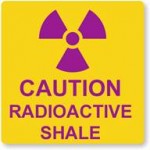From an Article of Forbes.com, April 24, 2013
A truck carrying drill cuttings from a hydraulic fracturing pad in the Marcellus Shale was rejected by a Pennsylvania landfill near the end of April after it set off a radiation alarm. The truck was emitting gamma radiation from radium 226 at almost ten times the level permitted at the landfill. The MAX Environmental Technologies truck was first quarantined at the landfill, which is operated by MAX, and then sent back to the fracking pad—Rice Energy‘s Thunder II pad in Greene County—to be redirected to a site that can accept higher levels of radiation.
“It’s low-level radiation, but we don’t want any radiation in South Huntingdon,” Tom Cornell, a township supervisor where the landfill is located, told the Pittsburgh Tribune Review. The cuttings in the truck were found to emit 96 microrem per hour of radiation, and the landfill is required to reject materials that emit more than 10 microrem. The EPA’s standard for air pollution is 10,000 microrem per year (also known as 10 millirem/year).
Originally this story stated the radiation level in the truck was below EPA’s air-pollution standard for radium-226. But Pennsylvania measures radiation in hourly emissions and EPA’s standard in terms of yearly emissions. The radiation level in the truck is roughly 84 times higher than EPA’s standard.
Radium 226 is a naturally occurring radioactive material that forms from the decay of uranium-238. It emits alpha and gamma radiation, and it tends to accumulate in bone if inhaled or ingested, according to EPA:
“Long-term exposure to radium increases the risk of developing several diseases. Inhaled or ingested radium increases the risk of developing such diseases as lymphoma, bone cancer, and diseases that affect the formation of blood, such as leukemia and aplastic anemia. These effects usually take years to develop. External exposure to radium’s gamma radiation increases the risk of cancer to varying degrees in all tissues and organs.”
Radium is a well known contaminant in fracking operations, particularly in the Marcellus Shale formation.
“The material in question was radium 226, which is what we expect from shale drill cuttings,” said John Poister, spokesman for Pennsylvania’s Department of Environmental Protection. “Every landfill in the state has radiation monitors, and this showed the system did work.” MAX has applied for a permit to accept a higher level of radiation at its South Huntingdon landfill.
Pennsylvania claims to be “the only state that requires through regulation that landfills monitor for radiation levels in the incoming wastes.”
The location of Rice Energy’s Thunder 2 well pad is just a few miles north of Monongalia County, WV, and a few miles east of Marshall and Wetzel counties in the far southwestern corner of Pennsylvania.
“Should waste trigger a radiation monitor, the landfill must use a conservative and highly protective protocol that DEP developed to determine if the amount and concentration of the radioactive material can be accepted. This protocol ensures that the materials, such as Marcellus Shale drill cuttings and other sources of naturally occurring radiation in the waste stream, do not pose a risk to public health during disposal.”
Radium is also perceived as a threat to water quality. The brine that returns to the surface after hydraulic fracturing has been found to contain up to 16,000 picoCuries per liter of radium-226 (pdf). The discharge limit in effluent for Radium 226 is 60 pCi/L, and the EPA’s drinking water standard is 5 pCi/L.
In January the Pennsylvania DEP announced it would undertake a year-long peer reviewed study of radiation contamination associated with fracking wells.
“The agency will collect samples of flowback water, rock cuttings, treatment solids and sediments at well pads and wastewater treatment and waste disposal facilities,” according to a DEP news release. “The study will also analyze the radioactivity levels in pipes and well casings, storage tanks, treatment systems and trucks.”

